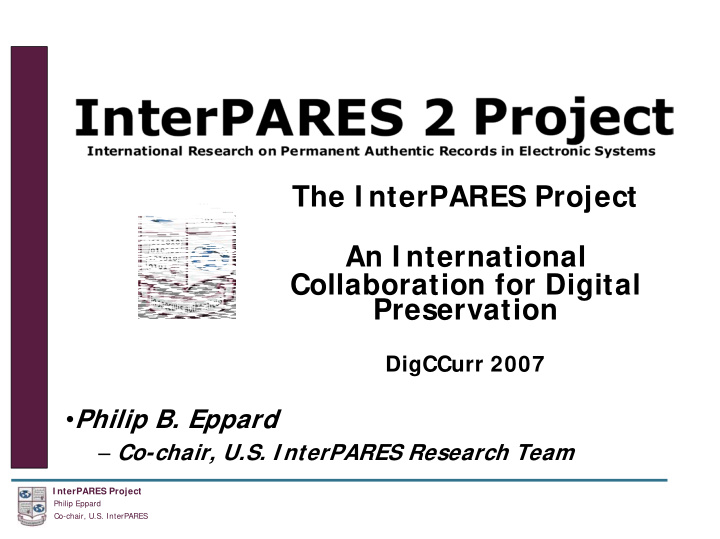



The I nterPARES Project An I nternational Collaboration for Digital Preservation DigCCurr 2007 • Philip B. Eppard – Co-chair, U.S. I nterPARES Research Team I nterPARES Project Philip Eppard Co-chair, U.S. InterPARES
Background to I nterPARES ● First UBC Project, 1994-1997 ● Creating and maintaining records ● Authenticity of records ● DoD 5015.2 standard for electronic records management systems I nterPARES Project Philip Eppard Co-chair, U.S. InterPARES
I nterPARES 1 1999 - 2001 ● 13 countries in 4 continents, 60 researchers ● Public and private sectors ● Professional stakeholders and academics ● Archival science, diplomatics and records management, plus computer science and engineering, jurisprudence, policy I nterPARES Project Philip Eppard Co-chair, U.S. InterPARES
I nterPARES 1 Purpose • To develop the theoretical and methodological knowledge essential for the permanent preservation of records generated electronically. • To formulate model policies, strategies, and standards capable of ensuring their preservation. I nterPARES Project Philip Eppard Co-chair, U.S. InterPARES
I nterPARES 1 Key Products ● Activity models for the selection and preservation functions ● Framework for requirements for assessing & maintaining authenticity of electronic records ● Benchmark requirements supporting the presumption of authenticity ● Baseline requirements supporting the production of authentic copies of electronic records I nterPARES Project Philip Eppard Co-chair, U.S. InterPARES
Benchmark Requirements Maintain expression of record attributes ● relating to identity and integrity Control access privileges ● Protective procedures to prevent loss or ● corruption of records Protective procedures to prevent media ● deterioration Procedures for maintaining documentation ● I nterPARES Project Philip Eppard Co-chair, U.S. InterPARES
Baseline Requirements � Maintain controls over records transfer, maintenance, and reproduction � Retain documentation of reproduction process and its effects � Capture changes to records through archival description I nterPARES Project Philip Eppard Co-chair, U.S. InterPARES
I nterPARES 2 2002 - 2006 • 15 countries in 4 continents, 74 researchers • Public and private sectors • Academics and professional stakeholders • Expanded interdisciplinary team, adding researchers from various sectors of the arts and sciences to team of archivists, preservationists, computer scientists and engineers, legal and policy experts. I nterPARES Project Philip Eppard Co-chair, U.S. InterPARES
I nterPARES 2 Purpose • Focus on newer kinds of electronic records: dynamic, interactive, experiential • Develop understanding of their creation, maintenance, and preservation • Develop methods for creating, maintaining, and preserving accurate, authentic, and reliable records in the arts, sciences, and government I nterPARES Project Philip Eppard Co-chair, U.S. InterPARES
Project Organization • Research Domains – Records Creation and Maintenance – Authenticity, Accuracy and Reliability – Methods of Appraisal and Preservation • Focus Areas – Arts activities – Science activities – E-Government activities I nterPARES Project Philip Eppard Co-chair, U.S. InterPARES
Project Organization (cont.) ● Cross-Domain Research Groups ● Description (Metadata) ● Modeling ● Policy ● Terminology I nterPARES Project Philip Eppard Co-chair, U.S. InterPARES
I nterPARES 2 Methodology • Literature reviews • Case studies • Surveys and general studies • Modeling: Data Flow diagrams, IDEF0, UML • Literary warrant analysis I nterPARES Project Philip Eppard Co-chair, U.S. InterPARES
Case Study Research • Case studies of dynamic, interactive, and experiential records in the arts, science and government • Intensive, structured interviews based on set of 23 questions that researchers need to answer • Case study findings essential for providing data to answer IP research questions I nterPARES Project Philip Eppard Co-chair, U.S. InterPARES
I nterPARES 2 Key Products • Manage Chain of Preservation Model • Business Driven Recordkeeping Model • Principles for Records Creators & Preservers • Guidelines for Digital Records’ Preservation • Guidelines for Individuals • Metadata and Archival Description Registry and Analysis System (MADRAS) • Terminology database I nterPARES Project Philip Eppard Co-chair, U.S. InterPARES
I nterPARES and Digital Curation • Training new researchers and educators • Case study methodology and examples • Integrating preservation with other processes • Metadata schema analysis • Policy recommendations I nterPARES Project Philip Eppard Co-chair, U.S. InterPARES
Further I nformation • InterPARES Website: www.interpares.org • U.S. InterPARES Website: www.gseis.ucla.edu/us-interpares • MADRAS: www.gseis.ucla.edu/us-interpares/madras I nterPARES Project Philip Eppard Co-chair, U.S. InterPARES
Recommend
More recommend